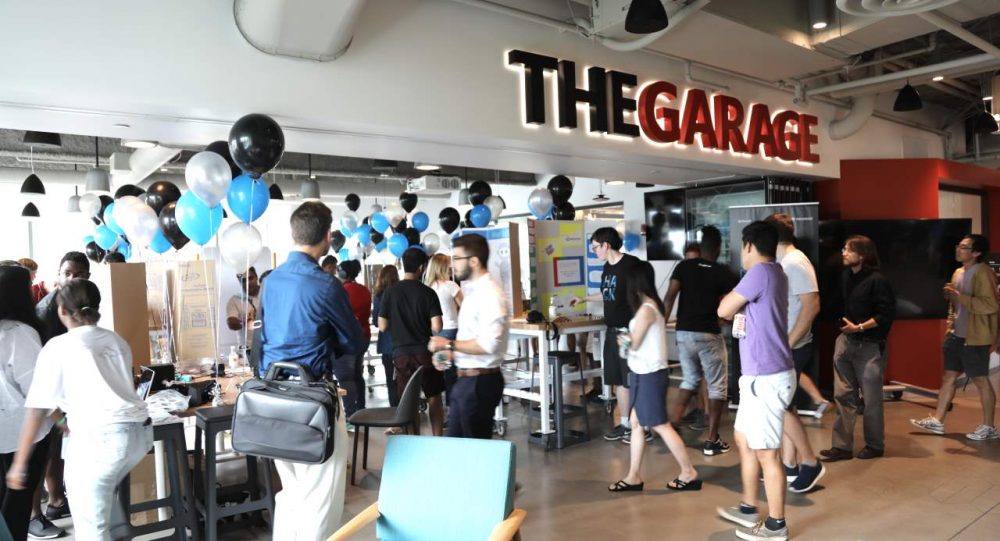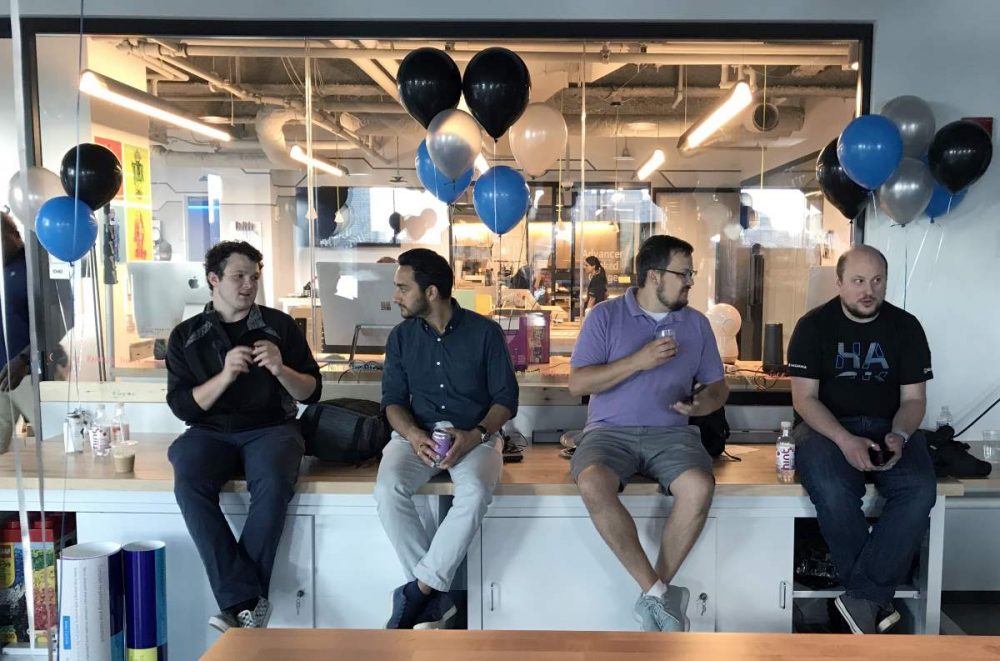Microsoft Garage has been a force in affecting positive change within the company, practicing new ways of thinking and spreading a growth mindset culture to employees as well as partners outside the company. Microsoft’s global Hackathon is a key player in CEO Satya Nadella’s culture change priorities driving innovations that empower customers to achieve more. The Garage at NERD, located in Cambridge, MA is one of many Garage locations worldwide making big strides in challenging conventional ways while furthering business impact.

The Garage at NERD during the Hackathon 2018 Science Fair
The New England Research and Development Center (NERD) is steeped in a rich community of forward-thinking institutions that are molding some of the best minds of the future. One of the newer Garage locations, The Garage – NERD is in a unique position of having the perfect vantage point to measure the pulse of research giants like MIT right next door and invite these institutions and local Boston communities into the Garage space to collaborate and share learnings.
“It’s about the people,” said Linda Thackeray, Director of The Garage at NERD. “We’re here to help employees and teams drive employee-led innovation at the company, for products and other areas employees are passionate about. We do that by creating opportunities to experiment and collaborate, not only within the Microsoft family, but with the local community as well. Look where we are! The greater Boston area is loaded with unique and robust talent and industry tech.”
The product development teams at NERD are at the forefront of the customer obsession initiative. The Docs Collaboration team took advantage of Microsoft’s annual Hackathon to create a proof of concept that could change the way Office builds app features. Ben Wilde, principal program manager on the Docs team, led the hack project which focused on adding key features to Office apps to enable richer and smarter collaboration. “A handful of us have been on a bit of a crusade to ensure that we’re solving real, high-impact customer problems that we’ve identified during actual conversations with our users, understanding what challenges they face when collaborating and coming up with creative solutions to eliminate their friction.” Though the project was about Office collaboration features, their team’s journey started months before Hackathon when the Docs team as a larger group began talking with customers in a more concentrated effort to get to the root of customer needs.
“For me personally the Hackathon has emboldened me and proved that the process works – I feel even more convinced now. This is something we’re all passionate about and we truly believe this is how we should be driving features.”
Wilde and team documented all their learnings and research, including customer conversations, and how they approached customer research as a process. A playbook of how to build features that solve actual customer problems, with data and feedback to validate what features should be prioritized. “At a high level, the process we went through started with building empathy and understanding user needs – the foundational sit-down-and-talk-to-customers approach. And more important than talking is listening, understanding where they feel friction, where things work and don’t work,” Wilde explained. From those conversations the team created feature concepts that they showed to customers and investigated which were the most impactful for collaboration. Those ideas became the key features that were prototyped during Hackathon and showcased at The Garage NERD Science Fair at the end of Hackathon, where their project won the Business Impact award.

Hackathon 2018 Science Fair, Business Impact award winners at Cambridge, MA: Terrell Cox (NERD Site GM), Lyndsy Stopa, Ben Wilde, Daniel Chattan, Anunaya Pandey, Garrigan Stafford, with David Ku, CVP
Lyndsy Stopa, a senior software engineer on the Docs team, was excited to talk about how the work they did began a larger conversation around what would need to happen to get these customer-backed features into product. “The more people that see this successful proof of concept the better. If you asked us, we’d love to build these features into the product tomorrow. At the same time, we also know the limitations.” While details of the features can’t be revealed, the work they did exploring the existing codebase and hooking up other Microsoft technologies for a working prototype, in true hack fashion, allowed them to think about possible implementation paths.
Anunaya Pandey, software engineer on the project, recalled the many discussions they had while showing their work to colleagues. “The fact that it was a hackathon meant that we could focus on what the experience for the customer was going to be like, versus how this was all to be implemented as part of a product. And that’s generally the opposite of how we traditionally do things. We wanted to be able to show how this was going to look inside of an app.”
“Hackathon for us is one step in a larger journey where we’re trying to shift culture and get people on board with this approach to building features.” Daniel Chattan, principal software engineer also on the Docs team, shared other takeaways. “We had an intern, Garrigan Stafford, who jumped in to work on the hack project. He was from a different product team, didn’t know our code base at all – and he was able to make changes very quickly. It challenged a lot of our preconceptions that there was a big on-ramp to be able to do these things and for new people to get into this space.”
The project also used Microsoft cognitive services and machine learning to interpret and infer user intent while collaborating and suggest actions at opportune moments. More recently as a larger group, the Docs team has expanded to include more data scientists with a machine learning focus. Chattan explained how they got more out of cognitive services than functional impact. “This was a great way to demonstrate thinking differently about how you can pull these things like AI and ML into thinking about a feature. Rather than think, ‘OK, we have this feature, now how do we fit cognitive services into it?’ the approach that we presented is ‘We have a feature we’re building that’s trying to accomplish something specific for the user, how can cognitive services help the user as opposed to helping the feature?’ It leads to a more natural connection of those two things.”

Garrigan Stafford, Anunaya Pandey, Ben Wilde, and Daniel Chattan in the Garage – NERD Maker space
It’s about a different mindset, open to change, embracing experimentation, and validating with customers. All are values that the project team is championing within their immediate organization, and values that Garage continues to foster within the company.
Post-hackathon, the team is also seeing a shift happening in their work group in how people are approaching feature development by being more incremental. “Let’s get to a minimum bar functionality,” explained Chattan, “then iterate again, then iterate again, which allows us to move very quickly and see the results of what we’re building and do fast course-corrections. We’re building more incrementally to incorporate user learning into the process, so we can learn as we go instead of creating a big monolith that a user sees for the first time only after it’s finished.”
It may sound like a simple idea, practicing this level of customer-obsession, but when trying to steer feature development there are other factors that come into play, such as demand for resources, and prior commitments that must be brought to completion before any new work can begin. The project team will continue their customer-validation approach for new iterations of the hack project, while relentlessly pursuing the same in their day jobs for current features they’re working on.
“For me personally the Hackathon has emboldened me and proved that the process works – I feel even more convinced now. This is something we’re all passionate about and we truly believe this is how we should be driving features.” Wilde explained. This begs the question then – how does management feel about it? “Management is in spiritual agreement. Everyone we’ve talked to is supportive and clearly sees the value of the features and the approach. But it’s difficult to say right now if we can pull together the necessary resources.”
With time, the team remains optimistic that their features, and their processes, will be embraced more widely as they continue their journey. Just as Wilde and his team are on a mission to affect culture-change in product development within Office, The Garage pursues culture-change for the entire company, so individuals, groups and organizations can provide greater business impact using Garage programs. This week, The Garage at NERD opened its doors to HUBWeek, a weeklong Boston festival where entrepreneurs, artists, and academics come together to collaborate on creating an inclusive and diverse future for art, science, and tech. Another example of the connective force of The Garage, and how a vibrant community continues to grow, full of doers, thinkers, and change-makers that will shape the next big ideas.
Read more about The Garage – NERD, check out a project shipped by Garage interns, and learn more about internship opportunities.
